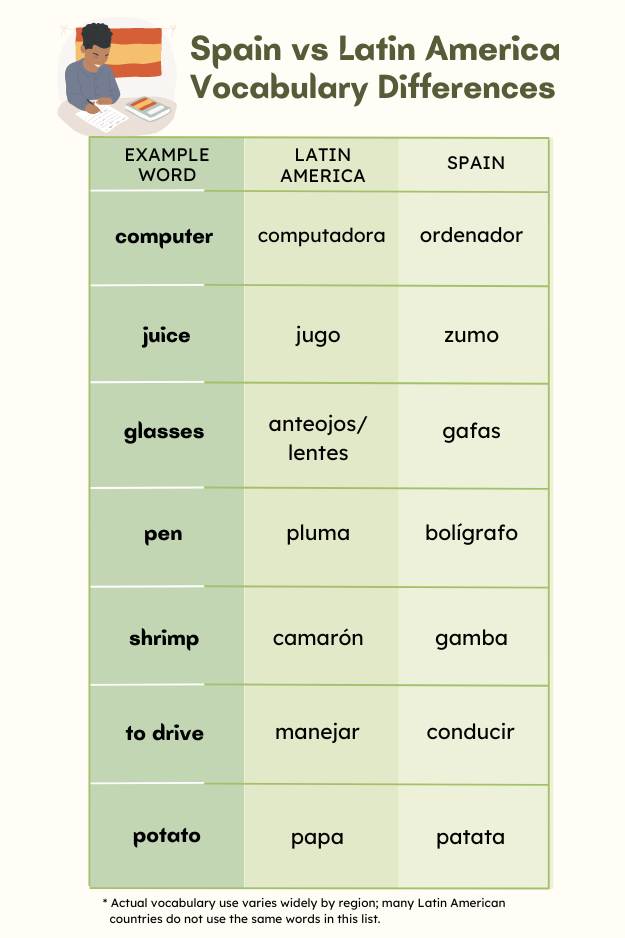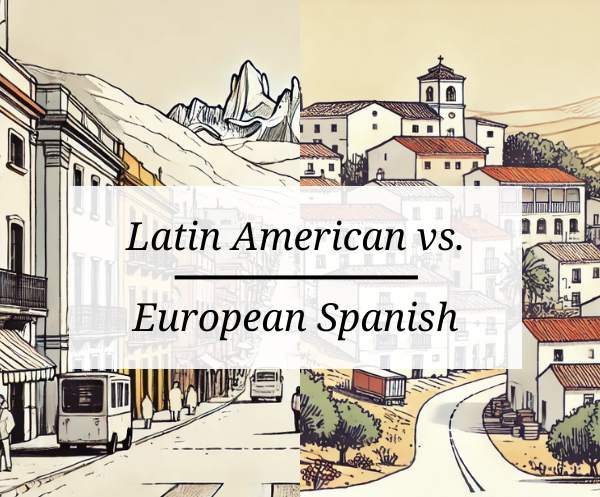Is There a Difference Between Latin American Spanish and European Spanish?
Spanish is one of the most widely spoken languages in the world, with over 550 million native speakers spread across 21 countries. Despite this shared language, there are significant differences between the Spanish spoken in Latin America and that spoken in Spain. These differences can be categorized into variations in vocabulary, grammar, pronunciation, and even cultural contexts. Understanding these distinctions is crucial for effective communication and can be especially important for businesses, travelers, and language learners.
Vocabulary Differences

One of the most noticeable differences between Latin American Spanish and European Spanish is vocabulary. Many everyday words differ across these regions, sometimes leading to confusion or misunderstandings. For instance, the word for “car” in Spain is “coche,” whereas in most of Latin America, it’s “auto” or “carro.” Similarly, “computer” is “ordenador” in Spain and “computadora” in Latin America.
Additionally, there are words that exist in both dialects but have different meanings. The word “torta” in Spain refers to a type of flatbread, while in Mexico, it means a sandwich. Another example is “piso,” which in Spain means “apartment” but refers to “floor” in Latin America. This variance in vocabulary extends to many other everyday items and can sometimes lead to humorous or confusing situations.
Read also: How Different Is Mexican Spanish from Spain Spanish?
Vocabulary Differences Table
| Spain | Latin America | Meaning |
|---|---|---|
| coche | auto/carro | car |
| ordenador | computadora | computer |
| piso | departamento | apartment |
| tarta | pastel | cake |
| zumo | jugo | juice |
| conducir | manejar | to drive |
| gafas | anteojos/lentes | glasses |
| móvil | celular | mobile phone |
| patata | papa | potato |
| coger | agarrar | to take |
| habitación | cuarto | room |
| melocotón | durazno | peach |
| albaricoque | damasco | apricot |
| frutero | frutera | fruit bowl |
| nevera | refrigerador | refrigerator |
| batidora | licuadora | blender |
| bolígrafo | pluma | pen |
| calcetines | medias | socks |
| golosinas | dulces | sweets |
| gamba | camarón | shrimp |
| bombilla | foco | light bulb |
Note: The vocabulary differences highlighted in this infographic are generalized for simplicity. In reality, the specific words used can vary significantly depending on the region. Many countries in Latin America do not use the same vocabulary even for the words listed here, reflecting the rich diversity within the Spanish-speaking world.
Grammar Differences
Grammar also exhibits several distinctions between the two Spanish dialects. One significant difference is the use of “vosotros” and “ustedes.” In Spain, “vosotros” is used as the informal plural “you,” while “ustedes” is reserved for formal situations. In contrast, “ustedes” is used for both formal and informal plural “you” in Latin America. This difference can impact how people perceive formality and politeness in various contexts.
Another grammatical difference lies in the use of the past tense. In Spain, the present perfect tense (e.g., “he comido” - I have eaten) is commonly used to describe recent actions, whereas in Latin America, the simple past tense (e.g., “comí” - I ate) is more frequently used for the same purpose. This can change the way past events are narrated and understood across the regions.
Pronunciation Differences
Pronunciation is another area where Latin American and European Spanish diverge. One of the most notable differences is the pronunciation of the letter “c” before “e” or “i” and the letter “z.” In Spain, these letters are pronounced with a “th” sound (similar to the English “th” in “think”), known as “distinción.” In contrast, in Latin America, these letters are pronounced as “s,” a phenomenon known as “seseo.”
Another pronunciation difference is the treatment of the letter “s” at the end of syllables or words. In many parts of Latin America, especially in the Caribbean, the “s” is often aspirated or dropped, leading to pronunciations like “ehtá” instead of “está” for “is.” This is less common in Spain, where the “s” is usually pronounced clearly.
Cultural and Contextual Differences
Beyond vocabulary, grammar, and pronunciation, cultural contexts and expressions also vary significantly between Latin American Spanish and European Spanish. Idiomatic expressions, slang, and even humor can differ widely, reflecting the diverse cultures within the Spanish-speaking world.
For example, the term “guagua” in the Canary Islands of Spain and some Latin American countries like Cuba and Puerto Rico refers to a bus, while in Chile, it means “baby.” Similarly, the word “paja” in Spain might refer to straw, but in Argentine Spanish, it has a vulgar connotation. These differences highlight the importance of understanding cultural contexts when communicating across regions.
Practical Implications
For businesses and professionals, these differences can have practical implications. A company aiming to market its products across Spanish-speaking countries might need to localize its content to cater to regional variations in language. This includes adapting vocabulary, grammar, and even cultural references to ensure the message is clear and engaging for the target audience.
For travelers, being aware of these differences can enhance communication and help avoid misunderstandings. Learning region-specific terms and expressions can make interactions smoother and more enjoyable.
For language learners, understanding these differences can aid in choosing the right dialect to study based on their goals. Whether learning Spanish for travel, business, or personal interest, being aware of regional variations can make the learning process more effective and culturally enriching.
Conclusion
In summary, while Latin American Spanish and European Spanish share a common foundation, they exhibit significant differences in vocabulary, grammar, pronunciation, and cultural context. These differences reflect the rich diversity of the Spanish-speaking world and underscore the importance of understanding regional variations for effective communication. Whether for business, travel, or language learning, appreciating these distinctions can enhance interactions and deepen cultural connections across Spanish-speaking countries. For more on the linguistic roots of Spanish, you can read about what Spanish is made of here.





